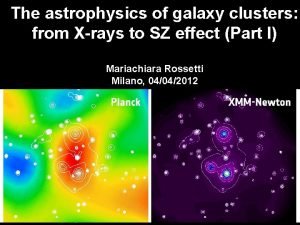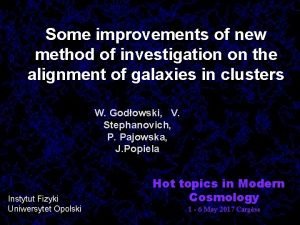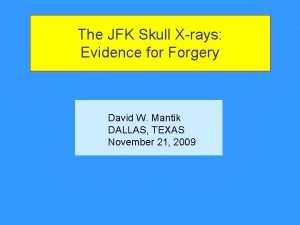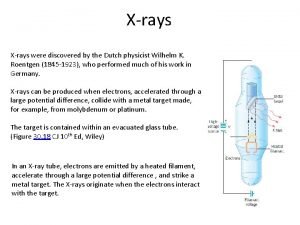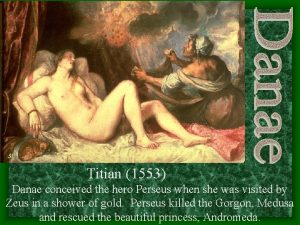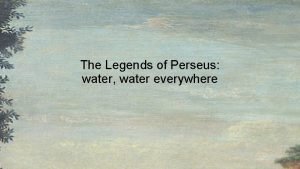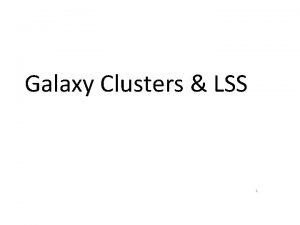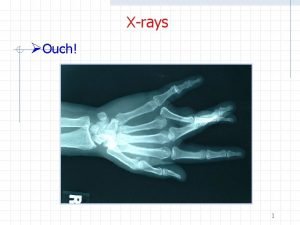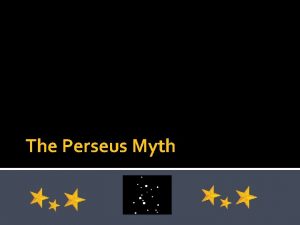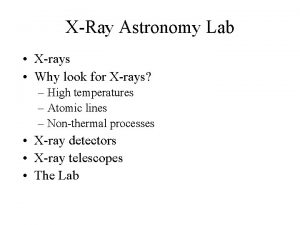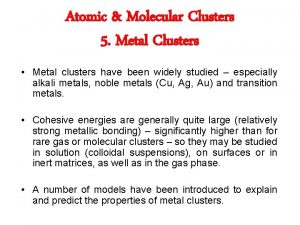Galaxy Clusters Perseus Cluster in Xrays Why study
















- Slides: 16

Galaxy Clusters Perseus Cluster in X-rays

Why study clusters? Clusters are the largest virialized objects in the Universe. n n n Cosmology: tail of density peak distribution Impact of extreme environments Physics of galaxy formation + feedback Magnifying lenses on the universe Practical: Many galaxies in single field Negative: Only ~5% of galaxies are in clusters!

Cluster galaxies, mostly red. A 2218 – a cluster at redshift 0. 23 Gravitationally lensed background galaxies

Color-magnitude-density relation n n Cluster galaxies are mostly red sequence. Fewer blue galaxies in clusters; a continuous trend at high-L, more abrupt at low-L. Luminosity is more important than environment Even isolated regions have passive galaxies What makes galaxies blue red in clusters? Balogh et al. 2004

Ram-pressure stripping n n n n Observed in HI + optical/Ha. P=r. ICMv 2. When this pressure exceeds restoring gravitational force, gas is stripped: df/dz s < r. ICMv 2 Solve stripping radius. Virgo: 52% truncated (vs. 12% in field). Starvation? 6% “anemic”. Harrassment? 6% enhanced. Simulations work… but r. ICM needs to be high (like near cluster center). Virgo galaxy normal galaxy

Galaxy Collisions, Tides and Harassment • Tidal truncation • Slow encounter • Depends on gradient of potential • Big impact on the dark halo, but not significant for stellar component • Impulsive heating • Fast encounter • Importance increases as relative velocity decreases • Harassment • The cumulative effect of repeated encounters

Galaxy Collisions, Tides and Harassment Perturbation to velocity of star in galaxy 1 Galaxy 1 size x force gradient Time of encounter m r b V M Perturber, galaxy 2 Change of internal energy of galaxy 1 Binney & Tremaine “Galactic Dynamics”

Strangulation - removal of the gas halo Quite slow because gas reservoir needs to be depleted, which happens on several Gyr timescales. First suggested by Larson, Tinsley & Caldwell, 1984

Timescales for Galaxy Transformation ØHow rapid must the blue®red Red Peak Blue Peak transition be? ØTwo gaussian model always fits the data well – there is no room for an intermediate population. Øcolour evolves rapidly if timescale for star formation to stop is short Øif transformations occur uniformly in time: need t<0. 5 Gyr Øif transformations are more common in the past, longer timescales permitted ØAlso need to occur not exclusively in clusters.

Mechanisms n Ram-pressure n n Collisions / harassment n n Needs dense ICM and high velocities - clusters Density too low Most effective in groups: Groups are preferred place! "Strangulation" Removal of the gas halo: no more fuel supply n Similar to ram-pressure stripping but much easier! n Transformation too rapid

Clusters in X-rays n n Every photon in sacred! Spectra fit with plasma model for (T, ne, Z) in each 2 -D pixel. Cooling flow or cool core clusters: Center has lower T, peaked X-ray SB, higher metallicity. 70 -90% of clusters have cool cores: relaxed.

Surface Brightness n n n King model + isothermal hot gas produces a cored SB distribution (Cavaliere +Fusco -Femiano 1976) called a beta model: Chandra data shows additional cavities: Hot, low pressure bouyant. Possibly associated with intermittent AGN?

X-ray Scaling Relations n Suppose halos of all sizes are self-similar. Then: n n n Ethermal = Ekinetic k. Tx = ½ s 2 T x s 2. Free-free Lx = MT½ (+VT) L x T x 2. Combining Lx s 4. Observations show Lx Tx 3, with an even steeper relation at group scales. And s Tx 0. 64. What assumption is wrong? Xue & Wu 2000

Ponman, Sanderson, Finoguenov 2003 Entropy n n n A useful quantity to examine is “entropy”, S(R) T/ne 2/3. Self-similar case: S T. Observed: S T 2/3. Smaller systems have more diffuse hot gas. n n n Lx lowered relative to self-similar expectations. Radial profiles suggest cores, i. e. some process has set an “entropy floor” in the ICM. Cooling? Feedback?

De Grandi + Molendi 2001 Metallicity n n Clusters all have Z~0. 3 Z. Cool core clusters show elevated central metallicity. Central region shows more enrichment form Type I’s; outskirts from Type II’s. Could feedback that injected metals also inject energy? Probably not, but debated still. Finoguenov et al 2000

Clusters: Not so simple n n Decades ago, clusters were thought to be the simplest possible systems: Giant balls of gas in hydrostatic equilibrium sprinkled with old, passively evolving galaxies. Now, more questions than answers: Why are clusters galaxies so red and dead? n Why does intracluster gas show excess entropy? n What is responsible for enriching the ICM? n Are any/all of these answers related to our understanding of field galaxy formation? n
 Elliptical spiral and irregular
Elliptical spiral and irregular Galaxy clusters
Galaxy clusters Galaxy clusters
Galaxy clusters Galaxy clusters
Galaxy clusters Rotating anode
Rotating anode Gamma ray
Gamma ray Jfk x ray
Jfk x ray Wilhelm k roentgen
Wilhelm k roentgen National fcs standards
National fcs standards Why why why why
Why why why why Why do disk stars bob up and down as they orbit the galaxy?
Why do disk stars bob up and down as they orbit the galaxy? Why are career clusters important?
Why are career clusters important? Don't ask why why why
Don't ask why why why How was perseus conceived?
How was perseus conceived? Perseus characteristics
Perseus characteristics Perseus traits
Perseus traits Perseus crossing the threshold
Perseus crossing the threshold

